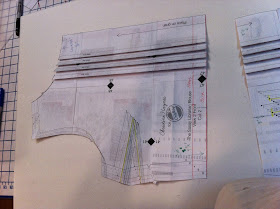I've had a few questions lately about how to shorten (or lengthen) a pattern, and more specifically, what to do if there is no line with instruction to "Lengthen or Shorten Here."
Where to shorten may vary for your figure, but these are the most common locations to shorten or lengthen a pattern:
BODICE: below the bust in the midriff (tummy) area.
LONG SLEEVE: either or both above or below the elbow, depending on where your elbow is. If the pattern does not have an elbow dart, then pick any place close to the middle.
PANTS: at the crotch, and either or both above and below the knee, or in the middle depending on the pant style.
SKIRTS: any place below the hip
This tutorial deals specifically with how to shorten a bodice pattern using the Tia Dress, #LN1312, but the same methods and rules apply for shortening the length of a pattern in any and all locations, standard or not.
There is no limit to the amount you can lengthen a pattern, but with short people, it's a bit more limiting. A pattern with seams across the body cannot be shortened more than the length of the midriff. Take away the seam allowance and we have 4" left to work with. 3" is about as much as can be taken away and still have a midriff left to sew!
How much to shorten? Take a look at the pattern back waist measurement. I'm using a size 2 for my example, which is made for a person that is 15 1/2" from base of neck to the waist. If you are taller or shorter than the measurement noted for your size, then you'll need to alter the pattern for length in the bodice.
Now you might ask- what is a backwaist??? The backwaist is a sewing term used to mean the measurement of the space from the neck to your waist. You'll be looking for that prominent vertebra at the
base of your neck that sticks out just a little more than the others. Your
waist is an anatomical space between your rib cage and pelvic bones where your body bends in half to pick something up. Yeah, we'd like to think it's the smallest part of our torso or we could pretend it's three fingers above the belly button, but that doesn't make it truth! If you have a hard time finding these two places, put on a chain necklace that has some weight to the front and a tightly cinched narrow belt. Feel around for that gap between those bones, and it may help to bend around a bit to check that the belt is settled into the right spot. Measure to the bottom of the belt. It's better to be too long than too short!
Now, if you'll turn to page 6 in your instruction booklet and work along with me, here is the LONG version of what it says there ...
So now we are ready to make our very own "lengthen or shorten here" line. This line must be
squared up with, perpendicular, or at right angles to the
grain line. When the grain matches Center Front or Center Back, then we use that line for reference instead. I'm using my trusty grid ruler of course, and with my pink highlighter, I'm going to draw my line about 1 1/2" away from the bottom. This avoids the seam allowance and I still have room to fold up and take away length.
I'll do the same with the back pattern piece. We want our lines to be in similar locations to each other. You can write a "length or shorten here" note to yourself if you like.
I'm thinking I'll be making this dress for a pre-teen who has not quite reached adult height and has a backwaist of 14 inches, so using a bit of math and the chart above, I need to take away 1 1/2 inches. I'll now make a parallel line 1 1/2 inches away from the first line.
Now comes the tricky part! Just to make a crease, I've folded my pattern back and under along the first line.
Bringing that first line up to meet the second line, I pressed it flat in place. That excess length is now folded to the back and out of the way.
Do that to both pattern pieces. Now pin or tape it in place. With tape, time will more or less ruin your paper pattern, but if you aren't worried about longevity, tape is nice and secure.
See the black arrow pointing to a nasty jog? Our dart wouldn't come out very well if we tried to sew it like that! We need to take care of the "jogs" we've created with our alteration. The next step is to
straighten or
true all of these jogs by using a ruler to draw new lines using the same end points we had before.
That dart looks so much better!
Now do the same thing with the side seams. It's best to leave paper around your pattern until after all alterations are done, but if you've trimmed yours away already, don't dispair! Tape more paper to the sides and then straighten up that line.
If your pattern has more parts to the bodice, you'll use these same steps for all pieces around the midriff. Choose a location where there is relatively no fussy lines or decoration to deal with. Choose a location below the bust. Shorten above the bust if your bust point is high in relation to the pattern. Measuring is the only way to know the difference.
Now that you know how to lengthen or shorten, you may be interested in taking on a bigger project. Try one of my Pattern Resizing tutorials:
Part 1: Small to Large or
Part 2: Large to Small.
Happy Sewing!



















































